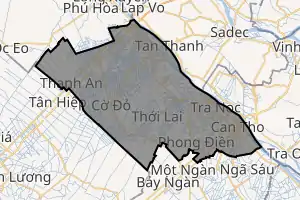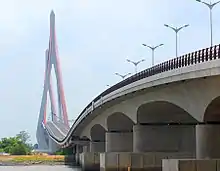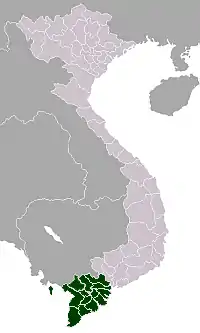Cần Thơ
Cần Thơ (standard Vietnamese: [kə̂n tʰəː] (![]() listen), Southern: [kʌŋ˨˩ tʰəː]) is the fourth-largest city in Vietnam, and the largest city in the Mekong Delta.[3][4]
listen), Southern: [kʌŋ˨˩ tʰəː]) is the fourth-largest city in Vietnam, and the largest city in the Mekong Delta.[3][4]
Cần Thơ
Thành phố Cần Thơ | |
|---|---|
| Cần Thơ City | |
 | |
 Seal | |
| Nickname(s): "The capital of the West" (Tây Đô) | |

| |
 Can Tho city map | |
| Coordinates: 10°02′N 105°47′E | |
| Country | |
| Region | Mekong Delta |
| Founded | 1789 |
| Capital | Ninh Kiều |
| Area | |
| • Total | 1,439 km2 (556 sq mi) |
| Elevation | 0 m (0 ft) |
| Population (2018)[1] | |
| • Total | 1,282,300 |
| • Density | 890/km2 (2,300/sq mi) |
| Time zone | UTC+07:00 (ICT) |
| Postal code | 90xxxx |
| Area codes | 292 |
| Vehicle registration | 65 |
| GDP (nominal) | 2013 |
| - Total | 3.6 billion USD |
| - Per capita | 2,980 USD[2] |
| Climate | Aw |
| Website | cantho.gov.vn |
It is noted for its floating markets, rice paper-making village, and picturesque rural canals.[4] It has a population of around 1,282,300 as of 2018,[1] and is located on the south bank of the Hậu River, a distributary of the Mekong River. In 2007, about 50 people died when the Cần Thơ Bridge collapsed, causing Vietnam's worst engineering disaster.[5] In 2011, Cần Thơ International Airport opened.[6]
The city is nicknamed the "western capital" (Vietnamese is Tây Đô), and is located 169 kilometres (105 miles) from Hồ Chí Minh City.
History: Vietnam War
During the Vietnam War, Cần Thơ was the home of the ARVN IV Corps capital. The ARVN 21st division was dedicated to protect the city of Cần Thơ, including the provinces of Chương Thiện (now in Hậu Giang), Bạc Liêu, An Xuyen (Cà Mau), Ba Xuyen (Soc Trang), and Kiên Giang. Before 1975, Cần Thơ was part of Phong Dinh province.and also On November 1, 1955, the third Light Division changed into the thirteenth Light Division, and the fifteenth, twelfth, and 106th regiments transformed into the 37th, 38th, and 39th regiments. The 37th and 38th Regiments consisted of battalions that originated in the present MR 3; The 39th regiment consisted of battalions from My Tho and Sa Dec in the Delta. The 39th Regiment participated in the successful campaigns against dissidents in Hua Hau in 1955-1956.
Administrative system
The city is an independent municipality at the same level as the other provinces of Vietnam. It was created in the beginning of 2004 by a split of the former Cần Thơ Province into two new administrative units: Cần Thơ City and Hậu Giang Province.
Cần Thơ is subdivided into nine district-level sub-divisions:
- 4 rural districts:
They are further subdivided into five commune-level towns (or townlets), 36 communes, and 44 wards.
Ninh Kiều, which has the well-known Ninh Kiều port, is the central district and also the most populated and wealthiest of these districts.[7]
The city borders the provinces of An Giang, Hậu Giang, Kiên Giang, Vĩnh Long and Đồng Tháp.
Transportation
Before 1975, National Highway 4 (now National Route 1A), bypassed the ferry from Binh Minh, VL to Cần Thơ where the ARVN 21st division patrolled heavily the ferry transportation to protect the civilians and ship merchants. National Highway 4 goes at the south from Cần Thơ to Ba Xuyen province (Soc Trang) where mainly heavily patrolled by ARVN soldiers to prevent route disruption.
Today, Cần Thơ is connected to the rest of the country by National Route 1A and Cần Thơ International Airport. The city's bridge, which is now completed, is the longest cable-stayed bridge in south-east Asia. The six-lane Saigon–Cần Thơ Expressway is being built in parts from Hồ Chí Minh City to Mỹ Tho. Hydrofoil express boats link this city with Hồ Chí Minh City. From Phú Quốc island, tourists can use the ferry, passenger bus or taxi to transfer to Cần Thơ.[8] There are many vehicles such as taxis, Grab motorbikes, buses, vans and coaches.
Tourism

The Mekong Delta is considered to be the "rice basket of Vietnam", contributing more than half of the nation's rice production. People say of Cần Thơ:
Cần Thơ gạo trắng nước trong, / Ai đi đến đó lòng không muốn về. ("Cần thơ's rice is white, its water clear. / Everyone who visit there, does not want to leave.")
Cần Thơ (shared with Hau Giang) is famous for its floating markets, where people sell and buy things on the river, as well as the bird gardens and the port of Ninh Kiều. The city offers a wide range of tropical fruits such as pomelo, longan, jackfruit, mango, guava, banana, rambutan, mangosteen, dragon fruit and durian. The Cần Thơ City Museum has exhibits on the city's history.[9]
- Tourist attractions
- Cần Thơ Bridge
- Thiền viện Trúc Lâm Phương Nam (Buddhist temple)
- Nam Nhã Pagoda
- Bình Thủy Temple
- The historic Bình Thủy house (nhà cổ Bình Thủy, 1870): a mix of French and Asian architecture
- Ninh Kiều Quay
- Cần Thơ pedestrian bridge
- Cái Răng Floating Market & Phong Điền Floating Market
- Bằng Lăng Stork Sanctuary (Thốt Nốt district)
- Canal tour
- Cần Thơ Cathedral
- Ông Chinese Pagoda
- Pitu Khôsa Răngsây Khmer Pagoda
- Quang Đức Pagoda
- Long Quang Pagoda
- Phật Học Pagoda[10]
- Mỹ Khánh tourist village
- Cần Thơ seminary

Education
Academic institutions in the city are Cần Thơ University, Cần Thơ Department of Education and Training, Cần Thơ University of Medicine and Pharmacy, Tây Đô University, Nam Cần Thơ University, Cần Thơ College, College of Foreign Economic Relations – Cần Thơ Branch, Medical College, Singapore International School at Can Tho,[11] Cần Thơ Technical Economic College[12] and Vocational College, with its well-known College of Agriculture and Mekong Delta Rice Research Institute, Cần Thơ University of Technology.
Climate
Under the Köppen climate classification, Cần Thơ has a tropical wet and dry climate. Cần Thơ's climate features two seasons: rainy (from May to November) and dry (from December to April). Average annual humidity is 83%, rainfall 1,635 mm (64 in) and temperature 27 °C (81 °F).
| Climate data for Cần Thơ | |||||||||||||
|---|---|---|---|---|---|---|---|---|---|---|---|---|---|
| Month | Jan | Feb | Mar | Apr | May | Jun | Jul | Aug | Sep | Oct | Nov | Dec | Year |
| Record high °C (°F) | 34.2 (93.6) |
35.2 (95.4) |
38.5 (101.3) |
40.0 (104.0) |
38.3 (100.9) |
37.3 (99.1) |
36.8 (98.2) |
35.5 (95.9) |
34.8 (94.6) |
35.8 (96.4) |
34.2 (93.6) |
34.0 (93.2) |
40.0 (104.0) |
| Average high °C (°F) | 30.0 (86.0) |
30.9 (87.6) |
32.5 (90.5) |
33.4 (92.1) |
32.9 (91.2) |
31.6 (88.9) |
31.1 (88.0) |
30.7 (87.3) |
30.7 (87.3) |
30.5 (86.9) |
30.2 (86.4) |
29.3 (84.7) |
31.1 (88.0) |
| Daily mean °C (°F) | 25.2 (77.4) |
25.9 (78.6) |
27.1 (80.8) |
28.3 (82.9) |
27.7 (81.9) |
27.0 (80.6) |
26.7 (80.1) |
26.6 (79.9) |
26.6 (79.9) |
26.7 (80.1) |
26.6 (79.9) |
25.4 (77.7) |
26.6 (79.9) |
| Average low °C (°F) | 22.1 (71.8) |
22.6 (72.7) |
23.7 (74.7) |
24.9 (76.8) |
25.0 (77.0) |
24.5 (76.1) |
24.3 (75.7) |
24.2 (75.6) |
24.3 (75.7) |
24.3 (75.7) |
24.1 (75.4) |
22.6 (72.7) |
23.9 (75.0) |
| Record low °C (°F) | 14.8 (58.6) |
17.3 (63.1) |
17.5 (63.5) |
19.2 (66.6) |
18.7 (65.7) |
19.0 (66.2) |
19.5 (67.1) |
19.7 (67.5) |
17.8 (64.0) |
18.7 (65.7) |
17.5 (63.5) |
16.5 (61.7) |
14.8 (58.6) |
| Average rainfall mm (inches) | 9 (0.4) |
2 (0.1) |
8 (0.3) |
40 (1.6) |
177 (7.0) |
218 (8.6) |
228 (9.0) |
240 (9.4) |
261 (10.3) |
321 (12.6) |
133 (5.2) |
38 (1.5) |
1,674 (65.9) |
| Average rainy days | 1.8 | 0.7 | 1.7 | 5.6 | 16.1 | 20.5 | 21.7 | 22.3 | 22.9 | 22.2 | 14.2 | 6.3 | 155.8 |
| Average relative humidity (%) | 81.6 | 80.1 | 78.3 | 79.3 | 84.3 | 87.0 | 86.7 | 87.5 | 87.9 | 87.1 | 84.9 | 82.8 | 84.0 |
| Mean monthly sunshine hours | 257 | 246 | 287 | 262 | 212 | 176 | 181 | 175 | 164 | 177 | 195 | 228 | 2,561 |
| Source: Vietnam Institute for Building Science and Technology[13] | |||||||||||||
Economy
After 120 years of development, the city now is the delta's most important center of economics, culture, science, and technology. It has a large freshwater port and two industrial parks.
Twin towns and sister cities

 Nice, France
Nice, France Shantou, China
Shantou, China Phnom Penh, Cambodia
Phnom Penh, Cambodia Amol, Iran
Amol, Iran Riverside, California
Riverside, California Jeollanamdo (South Jeolla), Korea
Jeollanamdo (South Jeolla), Korea
Notable people
- Lana Condor (born 1997), actress
Gallery




 Cần Thơ market
Cần Thơ market Museum of People's Armed Forces
Museum of People's Armed Forces
References
- "Area, population and population density in 2018 by province". Statistical Yearbook of Vietnam 2018. Statistical Publishing House, General Statistic Office of Viet Nam. 2019. p. 90. ISBN 9786047511082. Retrieved 13 May 2020.
- http://bizlive.vn/kinh-te-dau-tu/can-tho-thu-nhap-binh-quan-dau-nguoi-nam-2013-dat-629-trieu-dong-57775.html
- "Trang chu". Cổng Thông tin Điện tử thành phố Cần Thơ – CANTHO PORTAL (in Vietnamese and English). Ghi rõ nguồn "CanTho Portal" khi phát hành lại thông tin từ Portal này. 2012. Retrieved 15 October 2012.
- Ron Emmons (7 February 2012). Frommer's Vietnam: with Angkor Wat. John Wiley & Sons. ISBN 978-1-118-11997-6. Retrieved 15 October 2012.
- Jessica Rowson (3 October 2007). "50 deaths in Can Tho bridge collapse". New Civil Engineer. EMAP Ltd. Retrieved 15 October 2012.
- Emmons, p. 342.
- SGT (13 April 2012). "Ca Ba Old House is Can Tho classic". Vietnam.net Bridge. VIETNAMNET Bridge. Retrieved 15 October 2012.
- "best way to transfer from Phu Quoc to Cam Tho". Retrieved 3 October 2019.
- Emmons, p. 345.
- https://www.citypassguide.com/en/travel/can-tho/attractions/pagodas/phat-hoc-pagoda
- http://cantho.sis.edu.vn/
- http://www.ctec.edu.vn/ctec2013/
- "Vietnam Building Code Natural Physical & Climatic Data for Construction" (PDF) (in Vietnamese). Vietnam Institute for Building Science and Technology. Archived from the original (PDF) on 22 July 2018. Retrieved 23 July 2018.


